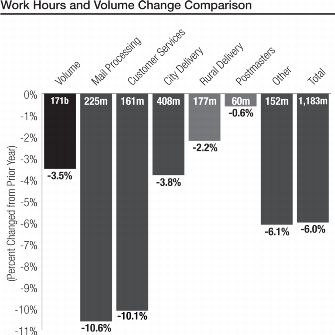Total work hours in 2010 of 1,183 million hours decreased by 75 million, or 6.0%, from 1,258 million work hours in 2009. Work hours in 2009 decreased an unprecedented 115 million hours from the 2008 total of 1,373 million hours, which was 50 million hours less than the 2007 total of 1,423 million hours. Contributing to these reductions were the previously noted incentives paid to 20,800 employees who elected to retire or resign during Quarter IV, 2009 and Quarter I, 2010. Another management initiative which contributed to the reduction was the adjustment of delivery routes that was initiated in response to the decline in mail volume.
Work hours decreased in all major functions in 2010 compared to 2009: city delivery declined by 16 million hours; rural delivery declined by 4 million hours; customer service declined by 18 million hours; and mail processing declined by 27 million hours.
Work Hours by Function (work hours in thousands)
|
2010
|
2009
|
2008
|
City Delivery
|
408,488
|
424,683
|
452,288
|
Mail Processing
|
224,645
|
251,200
|
293,108
|
Rural Delivery
|
177,152
|
181,090
|
189,950
|
Customer Service
|
160,621
|
178,715
|
203,952
|
Postmasters
|
59,609
|
59,995
|
60,621
|
Other, including Plant, Operational Support, Retail, and Administrative
|
152,432
|
162,342
|
173,435
|
Total Work Hours
|
1,182,947
|
1,258,025
|
1,373,354
|
Total work hours decreased in 2010 despite the addition of approximately 740,000 delivery points. Rural delivery hours decreased in 2010 despite the addition of over 387,000 new rural delivery points. The decreases reflect delivery optimization initiatives and the reduction in mail volume from the previous year. Although the total number of new delivery points increased in 2010, the growth rate was significantly lower in 2010 as compared to 2009. This is a direct reflection of the weak economy, with lower housing starts and sales.
As shown in the following chart and consistent with last year, in 2010 the rate of reduction in work hours has exceeded the rate of decline in mail volume in every category except rural delivery and postmasters. Rural delivery is where most of the delivery point growth is while postmasters represent mostly fixed costs. We continually strive to optimize the use of personnel and minimize variable costs. The challenge that remains is to reduce the fixed costs. This will include structural changes, many of which require legislative or regulatory approval.
Work Hours and Volume Change Comparison

Our 2009 work hours decreased by 115 million hours, partially offsetting higher labor rates. The unprecedented 115 million, or 8.4%, decrease in work hours resulted in large part from lower mail volume. Management initiatives and delivery route adjustments, initiated in response to the decline in workload, contributed to these reductions. Work hours decreased in all major functions.
Total Work Hours 2000–2010 (hours in millions)

Work hours have been reduced in ten of the last eleven years, with only 2005 showing a slight increase. Since 2002, work hour reductions have been the single biggest contributor to the ongoing achievement of savings targets.
